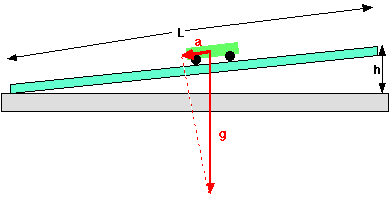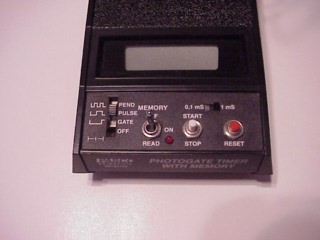AP Physics - Experiment 3a
Motion on an Inclined Plane (Galileo's
Experiment)
(Low-tech version... sort of...)


![[Up]](../../../NavIcons/Up.GIF)
![[Home]](../../../NavIcons/Home.GIF)
![[Help]](../../../NavIcons/Help.GIF) [Lab
Index]
[Lab
Index]
BHS
-> Staff
-> Mr. Stanbrough
-> AP
Physics-> AP Labs-> this
page
Purpose:
Is the free-fall acceleration at the surface of the Earth ("g")
constant, and if so, what is its value?
Discussion:
Around 1600, the amazing Galileo Galilei was able to show,
experimentally, not only that the acceleration of objects in free
fall was constant, but was able to determine a pretty good value for
this acceleration. Galileo performed this feat by rolling wooden
balls down long inclined planes, and he didn't even have the luxury
of a clock!
Today, we have the laboratory luxuries like air tracks,
stopwatches - even photogate timers! Surely we can do as well as old
Galileo...
Theoretically, we know that if an object starts from rest and
accelerates at a uniform rate, the distance that it travels in time t
is given by:

Therefore, if the acceleration of an object is constant, the graph
of  vs. t2 will be a straight line, with slope equal to half
the acceleration. This will answer the question of whether the
acceleration is constant or not, as well as provide a value of the
acceleration (if it is constant) - but how do you get from there to a
value of "g"?
vs. t2 will be a straight line, with slope equal to half
the acceleration. This will answer the question of whether the
acceleration is constant or not, as well as provide a value of the
acceleration (if it is constant) - but how do you get from there to a
value of "g"?

Look at the diagram above. L is the length of the incline, h is
the height of the elevated end. The acceleration of the cart , a,
acts along the incline, while the free-fall acceleration, g, acts
straight down. From similar triangles:

or:

Equipment:
|
air track & glider
|
meter stick or measuring tape
|
stopwatch or photogate timer
|
|
vernier caliper
|
carpenter's level
|
index card
|
|
small blocks or notebooks to prop up one end of the air
track
|
|
|
Setup:
- Construct a data table. You will be measuring several
distances along the air track (starting position and ending
position, actually) and the time that it takes the glider to cover
each distance. In order to establish the uncertainty of the time
measurement, it will be a good idea to run at least a few trials
for each distance. Then, you can calculate and use the average
time as the time for this distance. A heading for a sample data
table is shown below:

- Use a carpenter's level to level the air track. The glider
should move with a relatively constant velocity when you give it a
push, and should stay where you put it.
- Now, raise one end of the air track by placing a small block
of wood or a notebook under one end. The air track glider should
now accelerate slightly down the incline. The thickness of this
block is the height h in the equations given above. Measure this
distance, h, with a vernier caliper. Record your results, along
with a precision estimate.
- Measure and record the distance L along the air track. Don't
forget precision.
- If you are using a photogate timer, place the "main" photogate
at the starting point on the air track and the other 10 cm to 20
cm further down the track. Set the timer to record the time for
the glider to pass between the photogates (pulse mode). You may
need to construct a simple "flag" from an index card to trip the
photogates reliably.
|
|
|

|
|
|
|
The photogate timer's "control panel" set on pulse
mode.
|
Procedure Hints:
- When you "launch" the glider, be sure that you don't give it a
push - either up or down the track.
- You can keep the same starting position for every trial and
increment the ending position 10 cm to 20 cm per trial.
- After you have timed the glider over as wide a range of
distances as possible, find some other blocks that will give the
air track a few different angles.
Results:
- Calculate displacement, average time, and time squared for
each trial.
- Construct a displacement vs. time squared graph for each
air-track angle. Be sure to draw the best smooth curve through the
data points.
- If the best smooth curve happens to be a straight line,
calculate the slope of the line, and the acceleration of the
glider. Be sure to show a clear, organized sample calculation.
Don't forget precision.
- Calculate "g" for each air-track angle. Show a sample
calculation. You might as well calculate an "average g", also.
What is the precision estimate for this calculation?
Conclusions:
So, is the free-fall acceleration at the surface of the Earth
("g") constant, and if so, what is its value?
- How confident can you be in your results? Why do you think
so?
- What measurement contributed the most uncertainty to your
results? What could be done to improve it?


![[Up]](../../../NavIcons/Up.GIF)
![[Home]](../../../NavIcons/Home.GIF)
![[Help]](../../../NavIcons/Help.GIF) [Lab
Index]
[Lab
Index]
BHS
-> Staff
-> Mr. Stanbrough
-> AP
Physics-> AP Labs-> this
page
last update July 24, 2003 by JL
Stanbrough
![]() vs. t2 will be a straight line, with slope equal to half
the acceleration. This will answer the question of whether the
acceleration is constant or not, as well as provide a value of the
acceleration (if it is constant) - but how do you get from there to a
value of "g"?
vs. t2 will be a straight line, with slope equal to half
the acceleration. This will answer the question of whether the
acceleration is constant or not, as well as provide a value of the
acceleration (if it is constant) - but how do you get from there to a
value of "g"?
